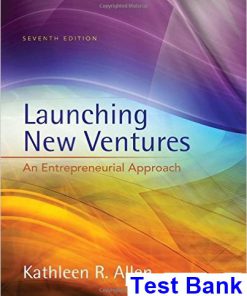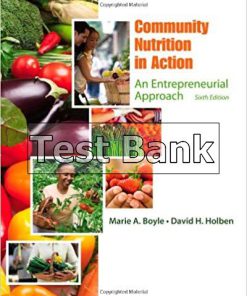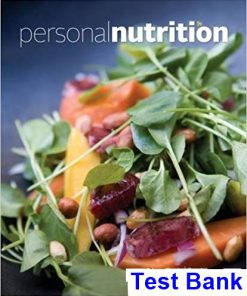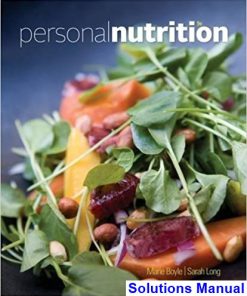Community Nutrition in Action An Entrepreneurial Approach 7th Edition Boyle Solutions Manual
$26.50$50.00 (-47%)
Community Nutrition in Action An Entrepreneurial Approach 7th Edition Boyle Solutions Manual.
You may also like
-
$26.50
$50.00
This is completed downloadable of Community Nutrition in Action An Entrepreneurial Approach 7th Edition Boyle Solutions Manual
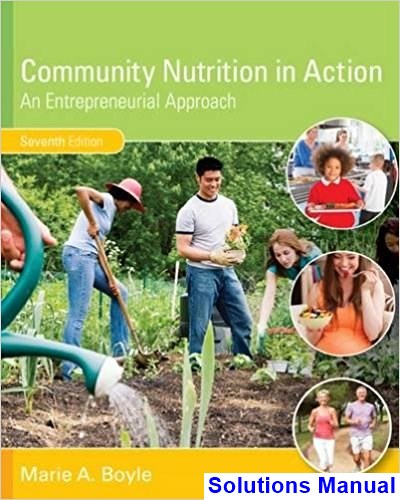
Product Details:
- ISBN-10 : 1305637992
- ISBN-13 : 978-1305637993
- Author: Marie Boyle
COMMUNITY NUTRITION IN ACTION introduces the program planning, policies, resources, and nutrition issues specific to community nutrition and provides an understanding of creating and implementing nutrition programs from various constituencies (elderly populations, children, impoverished populations, college students, etc.). Successful practitioners in community nutrition have proven to have a mind and skill set that opens them up to new ideas and ventures. Incorporating an entrepreneurial approach, this book helps readers learn how to take risks, try new technologies, and use fresh approaches to improving the public’s nutrition and health status. The book also delivers the core material important to those who will be active in solving community nutritional and health problems, including program delivery, nutrition education, nutrition assessment, and planning nutrition interventions.
Table of Content:
- Chapter 1: Opportunities in Community Nutrition
- Introduction
- The Concept of Community
- Opportunities in Community Nutrition
- Public Health and Community Interventions
- A Report Card for the Nation’s Health
- Community Nutrition Practice
- Community versus Public Health Nutrition
- Entrepreneurship in Community Nutrition
- Entrepreneurs and Intrapreneurs
- Social and Economic Trends for Community Nutrition
- Leading Indicators of Change
- Watchwords for the Future
- Case Study: Ethics and You
- Professional Focus: Community-Based Dietetics Professionals
- Chapter 2: Principles of Epidemiology
- Introduction
- The Practice of Epidemiology
- Investigating Causes of Diseases
- Basic Epidemiologic Concepts
- Rates and Risks
- The Epidemiologic Method
- Hypothesis Testing
- Explaining Research Observations
- Types of Epidemiologic Studies
- Ecological or Correlational Studies
- Cross-Sectional or Prevalence Studies
- Cohort Studies
- Case–Control Studies
- Controlled Trials
- Nutritional Epidemiology
- The Nature of Dietary Variation
- Epidemiology and the Community Nutritionist
- Case Study: Epidemiology of Obesity
- Professional Focus: The Well-Read Community Nutritionist
- Chapter 3: Understanding and Achieving Behavior Change
- Introduction
- Draw from Current Research on Consumer Behavior
- The Transtheoretical Model (Stages of Change)
- Motivational Interviewing
- The Health Belief Model
- The Theory of Planned Behavior
- Social-Cognitive Theory
- Programs in Action: EatFit Intervention Program
- Cognitive-Behavioral Theory
- The Diffusion of Innovation Model
- Findings Regarding Applications of Theory to Nutrition Interventions
- Put It All Together: Case Study 1
- Programs in Action: Intrapersonal and Interpersonal Health Education
- Professional Focus: Being an Effective Speaker
- Chapter 4: Community Needs Assessment
- Introduction
- Community Needs Assessment
- Basic Principles of Needs Assessment: Developing a Plan and Collecting Data
- Methods of Obtaining Data about the Target Population
- Issues in Data Collection
- Case Study 1: Women and Coronary Heart Disease
- Case Study 2: Nutrition Status of Independent Older Adults
- Basic Principles of Needs Assessment: Analyzing Data and Developing a Plan of Action
- Entrepreneurship in Community Needs Assessment
- Professional Focus: Getting Where You Want to Go
- Case Study: Planing a Needs Assessment Focused on School Children
- Chapter 5: Program Planning for Success
- Introduction
- Factors That Trigger Program Planning
- Steps in Program Planning
- Step 1: Review the Results of the Community Needs Assessment
- Step 2: Define Program Goals and Objectives
- Step 3: Develop a Program Plan
- Step 4: Develop a Management System
- Step 5: Identify Funding Sources
- Step 6: Implement the Program
- Step 7: Evaluate Program Elements and Effectiveness
- Programs In Action: A Learn-and-Serve Nutrition Program: The Food Literacy Partners Program
- Spreading the Word about the Program’s Success
- Use Entrepreneurship to Steer in a New Direction
- Professional Focus: The Nutrition Care Process: A Road Map to Quality Care
- Cast Study: Program Planning
- Chapter 6: The Art and Science of Policymaking
- Introduction
- The Process of Policymaking
- The People Who Make Policy
- Legitimizing Policy
- The Legislative and Regulatory Process
- Laws and Regulations
- How an Idea Becomes Law
- The Federal Budget Process
- The Political Process
- Current Legislation and Emerging Policy Issues
- The Community Nutritionist in Action
- Make Your Opinion Known
- Become Directly Involved
- Join an Interest Group
- Political Realities
- Case Study: Food Safety as a Food Policy Issue
- Professional Focus: Building Media Skills
- Chapter 7: A National Nutrition Agenda for the Public’s Health
- Introduction
- National Nutrition Policy in the United States
- National Nutrition Monitoring
- Nutrient Intake Standards
- Nutrition Survey Results: How Well Do We Eat?
- The National Agenda for Improving Nutrition and Health
- Dietary Guidance Systems
- Understanding the Nutrition Gap
- Implementing the Recommendations: From Guidelines to Groceries
- Case Study: From Guidelines to Groceries
- Professional Focus: Evaluating Research and Information on Nutrition and Health
- Chapter 8: Addressing the Obesity Epidemic: An Issue for Public Health Policy
- Introduction
- Defining Obesity and Overweight
- Epidemiology of Obesity and Overweight
- Medical and Social Costs of Obesity
- Determinants of Obesity
- Obesity Prevention and Treatment Interventions
- Adult Interventions
- Child and Adolescent Interventions
- Racial and Ethnic Disparities in Obesity
- Public Health Policy Options for Addressing the Global Obesity Epidemic
- Obesity Surveillance and Monitoring Efforts
- Awareness Building, Education, and Research
- Regulating Environments
- Pricing Policies
- Societal-Level Solutions
- Where Do We Go from Here?
- Programs in Action: Whole School, Whole Community, Whole Child Programs
- Case Study: Worksite Health Promotion Program for Prevention of Overweight
- Professional Focus: Diet Confusion: Weighing the Evidence
- Chapter 9: Health Care Systems and Policy
- Introduction
- An Overview of the Health Care Industry
- Private Insurance
- Government/Public Insurance
- The Uninsured
- Demographic Trends and Health Care
- The Need for Health Care Reform
- Health Care Reform in the United States
- Health Care Reform: Challenges and Opportunities Ahead
- Nutrition as a Component of Health Care Reform
- Medical Nutrition Therapy and Medicare Reform
- Future Changes in Health Care and Its Delivery
- Professional Focus: Ethics and the Nutrition Professional
- Case Study: Insurance Access
- Section Two: Community Nutritionists in Action: Delivering Programs
- Chapter 10: Food Insecurity and the Food Assistance Programs
- Introduction
- Counting the Food-Insecure in the United States
- Who Are the Food-Insecure in the United States?
- Causes of Food Insecurity in the United States
- Historical Background of Food Assistance Programs
- Welfare Reform: Issues in Moving from Welfare to Work
- Federal Domestic Nutrition Assistance Programs Today
- Filling In the Gaps to Strengthen the Food Resource Safety Net
- The Rising Tide of Food Assistance Need
- Programs in Action: Overcoming Barriers to Increasing Fruit and Vegetable Consumption
- Beyond Public Assistance: What Can Individuals Do?
- Case Study: Hunger in an At-Risk Population
- Professional Focus: Moving Toward Community Food Security
- Chapter 11: Mothers and Infants: Nutrition Assessment, Services, and Programs
- Introduction
- Trends in Maternal and Infant Health
- National Goals for Maternal and Infant Health: Healthy People 2020
- Healthy Mothers
- Maternal Weight Gain
- Adolescent Pregnancy
- Nutrition Assessment in Pregnancy
- Healthy Babies
- Nutrient Needs and Growth Status in Infancy
- Breastfeeding Recommendations
- Other Recommendations on Feeding Infants
- Primary Nutrition-Related Problems of Infancy
- Programs in Action: Using Peer Counselors to Change Culturally Based Behaviors
- Domestic Maternal and Infant Nutrition Programs
- The WIC Program
- Other Nutrition Programs of the U.S. Department of Agriculture
- Nutrition Programs of the U.S. Department of Health and Human Services
- Looking Ahead: Improving the Health of Mothers and Infants
- Case Study: Promotion of Breastfeeding
- Professional Focus: Leading for Success
- Chapter 12: Children and Adolescents: Nutrition Issues, Services, and Programs
- Introduction
- Healthy People 2020 National Nutrition Objectives
- Healthy People 2010 Final Review
- What Are Children and Adolescents Eating?
- Influences on Child and Adolescent Eating Patterns and Behaviors
- Weighing In on the Problem of Childhood Obesity
- Other Nutrition-Related Problems of Children and Adolescents
- Programs in Action: Combating Disordered Nutrition in Young Female Athletes
- Children with Special Health Care Needs
- Programs in Action: Nutrition Education Strategies for Preadolescent Girls
- The History of Child Nutrition Programs in Schools
- Nutrition Programs of the U.S. Department of Agriculture
- Nutrition Programs of the U.S. Department of Health and Human Services
- Improving Nutrition in the Childcare Setting
- Impact of Child Nutrition Programs on Children’s Diets
- Building Healthful School Environments
- Nutrition Education Programs
- Nutrition Education in the Public and Private Sectors
- Programs in Action: Empowering Teens to Make Better Nutrition Decisions
- Keeping Children and Adolescents Healthy
- Case Study: The Child Nutrition Program
- Professional Focus: The Art of Negotiating
- Chapter 13: Healthy Aging: Nutrition Assessment, Services, and Programs
- Introduction
- Demographic Trends and Aging
- Healthy Adults
- National Goals for Health Promotion
- Understanding Baby Boomers
- Nutrition Education Programs
- Health Promotion Programs
- Programs in Action: The Farm to Work Initiative: An Innovative Approach to Obesity Prevention
- Aging and Nutrition Status
- Primary Nutrition-Related Problems of Aging
- Nutrition Policy Recommendations for Health Promotion for Older Adults
- Evaluation of Nutrition Status
- Home- and Community-Based Programs and Services
- General Assistance Programs
- Nutrition Programs of the U.S. Department of Agriculture
- Nutrition Programs of the U.S. Department of Health and Human Services
- Private-Sector Nutrition Assistance Programs
- Nutrition Education and Health Promotion Programs for Older Adults
- Programs in Action: Bringing Food and Nutrition Services to Homebound Seniors
- Looking Ahead: Successful Aging
- Case Study: Postmenopausal Nutrition and Disease Prevention Program
- Professional Focus: Lighten Up—Be Willing to Make Mistakes and Risk Failure
- Chapter 14: Global Food and Nutrition Security: Challenges and Opportunities
- Introduction
- Mapping Poverty and Undernutrition
- Malnutrition and Health Worldwide
- Food Insecurity in Developing Countries
- The Role of Colonialism
- International Trade and Debt
- The Role of Multinational Corporations
- The Role of Overpopulation
- Distribution of Resources
- Agricultural Technology
- A Need for Sustainable Development
- People-Centered Development
- Nutrition and Development
- Scaling Up Nutrition
- Agenda for Action
- Making the World Fit for Children
- Focus on Children
- Focus on Women
- International Nutrition Programs
- Looking Ahead: The Global Challenges
- Personal Action: Opportunity Knocks
- Programs in Action: Vitamin A Field Support Projects
- Case Study: UNICEF’s Child Survival Campaign
- Section Three: Community Nutritionists in Action: Planning Nutrition Interventions
- Chapter 15: Gaining Cultural Competence in Community Nutrition
- Introduction
- Gaining Cultural Competence
- Terms Related to Cultural Competence
- Need for Cultural Competence
- Cultural Competence Models
- Cross-Cultural Communication
- Communication Styles
- Suggestions for Communicating Information
- Ways in Which Discussions about Food Can Open Dialogue
- Working with Interpreters
- Culturally Appropriate Intervention Strategies
- Explanatory Models
- LEARN Intervention Guidelines
- Practical Considerations for Community Interventions
- Programs in Action: Encouraging Breastfeeding among African American Women
- Essential Organizational Elements of Cultural Competence
- Case Study: Gaining Cultural Competence in a Muslim Community
- Professional Focus: Cross-Cultural Nutrition Counseling
- Chapter 16: Principles of Nutrition Education
- Introduction
- Applying Educational Principles to Program Design
- Learning across the Lifespan
- Developing a Nutrition Education Plan
- Programs in Action: Making Healthy Eating Fun for Students
- Nutrition Education to Reduce CHD Risk: Case Study 1
- Developing Lesson Plans to Reduce CHD Risk
- Conducting Formative Evaluation
- Designing Nutrition and Health Messages
- General Ideas for Designing Messages
- Conducting Summative Evaluation
- Entrepreneurship in Nutrition Education
- Case Study: Developing a Nutrition Education Plan for Older Adults at Congregate Feeding Sites
- Professional Focus: Being an Effective Writer
- Chapter 17: Marketing Nutrition and Health Promotion
- Introduction
- What Is Marketing?
- Develop a Marketing Plan
- Develop a Marketing Strategy
- Monitor and Evaluate
- Social Marketing: Community Campaigns for Change
- Social Marketing at the Community Level
- Programs in Motion: Motivating Children to Change Their Eating and Activity Habits
- A Marketing Plan for Heartworks for Women: Case Study 1
- Entrepreneurship Leads the Way
- Professional Focus: Social Media for Nutrition Professionals
- Case Study: Marketing Nutrition and Health Promotion
- Chapter 18: Managing Community Nutrition Programs
- Introduction
- The Four Functions of Management
- Planning
- Organizing
- Leading
- Controlling
- Management Issues for Heartworks for Women: Case Study 1
- The Critical Path
- Programs in Action: The Better Health Restaurant Challenge
- The Business of Community Nutrition
- Professional Focus: Time Management
- Chapter 19: Building Grantsmanship Skills
- Introduction
- Laying the Foundation for a Grant
- Generate Ideas
- Describe Goals
- Identify Funding Sources
- Identify Potential Collaborators
- Building the Proposal
- Components of a Proposal
- Budget
- Assembling the Final Product
- Review of the Grant Proposal
- The Logic Model
- Professional Focus: Teamwork Gets Results
- Appendix
- Appendix A: Nutrition Assessment and Screening
- Appendix B: Complementary Nutrition and Health Therapies
- Appendix C: The SMOG Readability Formula
- Appendix D: Part One: Community Needs Assessment Assignment
- Index
People Also Search:
community nutrition in action an entrepreneurial approach boyle
community nutrition in action an entrepreneurial approach 7th edition boyle
community nutrition in action an entrepreneurial approach
community nutrition in action an entrepreneurial approach 7th edition
community nutrition in action an entrepreneurial approach 7th edition download scribd
community nutrition in action an entrepreneurial approach 7th edition solution manual download pdf


